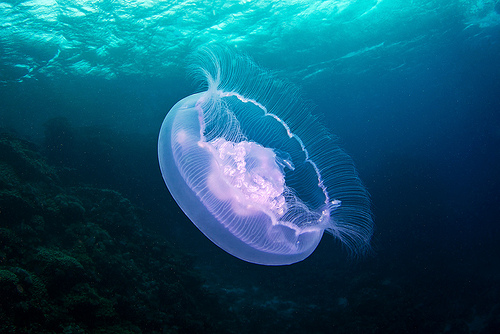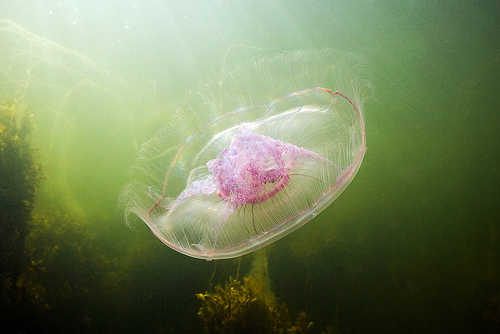Habitat

(all pictures on this page are of courtesy of Alexander Semenov)
The Moon
jelly is one of the most common jellyfish among others. It can
be found in almost all shallow marine and coastal regions. The
Moon jellyfish are not very good swimmers because of their short
tentacles and, therefore, are sometimes found washed up on the
shorelines. The map below shows the distribution of the Moon
jelly around the world in the dotted regions. Notice how the
Moon Jelly does not like to live in freezing cold waters,
avoiding the Arctic Ocean, but are widely distributed because
they can survive in waters varying from zero to thirty-one
degrees Celsius. The comfortable range for these
jellies are from eight to nineteen degrees Celsius. Remember
that these jellies don’t live in the deep portion of water due
to the fact that its food source is usually located at the
surface of the water and Moon Jellyfish relies on the current to
pull them along.

Where the food goes.. I go!
Like many other
animals, jellyfish migrate in the direction that they can likely
survive in. What helps you survive? Food. Jellyfish will move in
the direction of the greatest light because plankton moves in the
direction of light and where there’s the prey the predator is not
far behind. Jellyfish are usually seen popping up in the areas of
water during the warm seasons and causing trouble to fishermen. (Dr.
Bill Incatasciato, 2012) The moon jellyfish is a common jelly
amongst many others and their impact on the fishing market is no
surprise. Jellyfish can get tangled and damage nets that are put out
by fishermen and decrease the amount of fish caught. A study
supported by the JSPS and KSEF Core University Program on Fisheries
Science (FiSCUP) and International Collaboration Research on Giant
Jellyfish tried to determine the distribution and abundance of
jellyfish in the summer of Japan by measuring out the sound speed,
density, and target strength amongst three different types of
Jellyfish, in which the Aurelia aurita is one of them. The
results of these experiments were inconclusive because although all
three of the jellyfish are from the same order (Semaeostomeae) there
doesn’t seem to be any solid evidence to show a direct correlation
between the acoustic characteristics of these jellyfish. According
to Dr. Harlen the definition of acoustic scatter is “ultrasound
spectroscopy and sonar rely on the scattering of sound waves at
interfaces between different media”. These Scientists suggest that
jellyfish may differ their sound waves by species and not order.
Further experiments are needed to resolve the issue of figuring out
the abundance and distribution of jellyfish. (Miyajima,
Y.Y., et al. 2009)
Core University Program on Fisheries
Science (FiSCUP) and International Collaboration Research on Giant
Jellyfish tried to determine the distribution and abundance of
jellyfish in the summer of Japan by measuring out the sound speed,
density, and target strength amongst three different types of
Jellyfish, in which the Aurelia aurita is one of them. The
results of these experiments were inconclusive because although all
three of the jellyfish are from the same order (Semaeostomeae) there
doesn’t seem to be any solid evidence to show a direct correlation
between the acoustic characteristics of these jellyfish. According
to Dr. Harlen the definition of acoustic scatter is “ultrasound
spectroscopy and sonar rely on the scattering of sound waves at
interfaces between different media”. These Scientists suggest that
jellyfish may differ their sound waves by species and not order.
Further experiments are needed to resolve the issue of figuring out
the abundance and distribution of jellyfish. (Miyajima,
Y.Y., et al. 2009)
Temperatures effect on asexual
reproduction
In 2012 an experiment
published in the Journal of Experimental Marine Biology and Ecology
shows that there's a correlation between the temperatures of the
water and the food abundance directly affects the reproduction of
the Moon Jelly. The planulae of wild moon jellies were used for this
experiment and were placed into six different conditions food and
water conditions. The six conditions consisted of three different
temperature settings at 6 degrees Celsius, 12 degrees Celsius, and
18 degrees Celsius with alternating high and low supply of food.
These experiments proved to be successful; four types of asexual
budding were observed. The fully grown moon jellies were found to
reproduce by lateral budding, lateral budding by means of stolons,
reproduction from parts of stolons/stalks, and longitudinal fission
a t the two higher temperature settings. The results of this
experiment concluded that at higher temperatures with high food
supply the planulae settles onto a hard substrate into its colonies
faster and asexually reproduce more. Other experiments have been
concluded that moon jellyfish do not asexually reproduce in reaction
to harsh conditions, but with the abundance of food supply. Even if
the moon jellyfish was enriched with food, but the food supply is
low, they still wouldn’t asexually reproduce as often as they would
if the supply was high. The theory is that at higher temperatures
the planulae settles faster and therefore can start to grow; the
increased supply of food causes growth of tentacles that aid in the
consumption of food so, therefore food benefits those with more
tentacles. At low temperatures the planulae is said to settle at a
slower pace and if they don’t settle in an area after two weeks,
they die. Therefore, temperature is a key factor in the settlement
of the planulae and their survival. (Webster,
Clare N., et al. 2012.)
t the two higher temperature settings. The results of this
experiment concluded that at higher temperatures with high food
supply the planulae settles onto a hard substrate into its colonies
faster and asexually reproduce more. Other experiments have been
concluded that moon jellyfish do not asexually reproduce in reaction
to harsh conditions, but with the abundance of food supply. Even if
the moon jellyfish was enriched with food, but the food supply is
low, they still wouldn’t asexually reproduce as often as they would
if the supply was high. The theory is that at higher temperatures
the planulae settles faster and therefore can start to grow; the
increased supply of food causes growth of tentacles that aid in the
consumption of food so, therefore food benefits those with more
tentacles. At low temperatures the planulae is said to settle at a
slower pace and if they don’t settle in an area after two weeks,
they die. Therefore, temperature is a key factor in the settlement
of the planulae and their survival. (Webster,
Clare N., et al. 2012.)